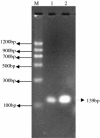Detection of viral aerosols by use of real-time quantitative PCR
- PMID: 32214624
- PMCID: PMC7087933
- DOI: 10.1007/s10453-009-9110-1
Detection of viral aerosols by use of real-time quantitative PCR
Abstract
PCR quantification is regarded as one of the most promising techniques for real-time identification of bio-aerosols. We have, therefore, validated a QPCR assay for quantification of a viral aerosol sample using the double-stranded DNA-binding dye SYBR green I, an economical alternative for quantification of target microorganisms. To achieve this objective we used mycobacteriophage D29 as model organism. Phage D29 aerosol was produced in an aerosol cabinet and then collected by use of an AGI liquid sampler. A standard curve was created by use of purified genomic DNA from the phage in liquid culture of known concentration measured by titration. To prevent false-positive results caused by formation of primer-dimers, an additional data-acquisition step was added to the three-step QPCR procedure; the new technique was called four-step QPCR. The standard curve was then used to quantify the total amount of phage D29 in liquid culture and aerosol samples. For liquid culture samples there was no significant difference (P > 0.05) between results from quantification of the virus using double-agar culture and QPCR. For aerosol samples, however, the result determined by the QPCR method was significantly (P < 0.05) higher than that from the double-agar culture method. The four-step SYBR green I QPCR method is a quick quantitative method for mycobacteriophage D29 aerosol. We believe that QPCR using SYBR green I dye will be an economical method for detection of airborne bio-aerosols.
Keywords: QPCR; SYBR green I; Viral aerosols.
© Springer Science+Business Media B.V. 2009.
Figures





References
-
- An HR, Mainelis G, White L. Development and calibration of real-time PCR for quantification of airborne microorganisms in air samples. Atmospheric Environment. 2006;40:7924–7939. doi: 10.1016/j.atmosenv.2006.07.020. - DOI
-
- Arikawa E, Sun Y, Wang J, Zhou Q, Ning B, Dial SL, Guo L, Yang J. Cross-platform comparison of SYBR green real-time PCR with TaqMan PCR, microarrays and other gene expression measurement technologies evaluated in the microarray quality control (MAQC) study. BMC Genomics. 2008;9:328. doi: 10.1186/1471-2164-9-328. - DOI - PMC - PubMed
-
- Eltringham IJ, Wilson SM, Drobnieski FA. Evaluation of a bacteriophage-based assay (phage amplified biologically assay) as a rapid screen for rapid screen for resistance to isoniazid, ethambutol, streptomycin, pyrazinamide and ciprofloxacin among clinical isolates of Mycobacterium tuberculosis. Journal of Clinical Microbiology. 1999;37:3528–3532. - PMC - PubMed
LinkOut - more resources
Full Text Sources
Other Literature Sources
